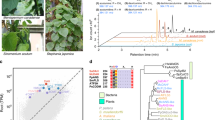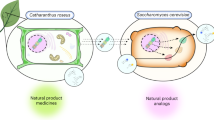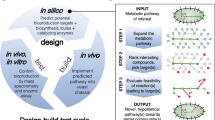Abstract
Halogenation, which was once considered a rare occurrence in nature, has now been observed in many natural product biosynthetic pathways1. However, only a small fraction of halogenated compounds have been isolated from terrestrial plants2. Given the impact that halogenation can have on the biological activity of natural products1, we reasoned that the introduction of halides into medicinal plant metabolism would provide the opportunity to rationally bioengineer a broad variety of novel plant products with altered, and perhaps improved, pharmacological properties. Here we report that chlorination biosynthetic machinery from soil bacteria can be successfully introduced into the medicinal plant Catharanthus roseus (Madagascar periwinkle). These prokaryotic halogenases function within the context of the plant cell to generate chlorinated tryptophan, which is then shuttled into monoterpene indole alkaloid metabolism to yield chlorinated alkaloids. A new functional group—a halide—is thereby introduced into the complex metabolism of C. roseus, and is incorporated in a predictable and regioselective manner onto the plant alkaloid products. Medicinal plants, despite their genetic and developmental complexity, therefore seem to be a viable platform for synthetic biology efforts.
This is a preview of subscription content, access via your institution
Access options
Subscribe to this journal
Receive 51 print issues and online access
$199.00 per year
only $3.90 per issue
Buy this article
- Purchase on Springer Link
- Instant access to full article PDF
Prices may be subject to local taxes which are calculated during checkout



Similar content being viewed by others
References
Neumann, C. S., Fujimori, D. G. & Walsh, C. T. Halogenation strategies in natural products biosynthesis. Chem. Biol. 15, 99–109 (2008)
Gribble, G. W. The diversity of naturally produced organohalogens. Chemosphere 52, 289–297 (2003)
Vaillancourt, F. H., Yeh, E., Vosburg, D. A., Garneau-Tsodiova, S. & Walsh, C. T. Nature’s inventory of halogenation catalysts: oxidative strategies predominate. Chem. Rev. 106, 3364–3378 (2006)
van Pée, K. H. & Patallo, E. P. Flavin-dependent halogenases involved in secondary metabolism in bacteria. Appl. Microbiol. Biotechnol. 70, 631–641 (2006)
Blasiak, L. C. & Drennan, C. L. Structural perspective on enzymatic halogenation. Acc. Chem. Res. 42, 147–155 (2009)
Zehner, S. et al. A regioselective tryptophan 5-halogenase is involved in pyrroindomycin biosynthesis in Streptomyces rugosporus LL-42D005. Chem. Biol. 12, 445–452 (2005)
Zhu, X. et al. Structural insights into regioselectivity in the enzymatic chlorination of tryptophan. J. Mol. Biol. 391, 74–85 (2009)
Yeh, E., Garneau, S. & Walsh, C. T. Robust in vitro activity of RebF and RebH, a two-component reductase/halogenase, generating 7-chlorotryptophan during rebeccamycin biosynthesis. Proc. Natl Acad. Sci. USA 102, 3960–3965 (2005)
Yeh, E. et al. Flavin redox chemistry precedes substrate chlorination during the reaction of the flavin-dependent halogenase RebH. Biochemistry 45, 7904–7912 (2006)
Yeh, E., Blasiak, L. C., Koglin, A., Drennan, C. L. & Walsh, C. T. Chlorination by a long-lived intermediate in the mechanism of flavin-dependent halogenases. Biochemistry 46, 1284–1292 (2007)
Bitto, E. et al. The structure of flavin-dependent tryptophan 7-halogenase RebH. Proteins 70, 289–293 (2008)
Sánchez, C. et al. Combinatorial biosynthesis of antitumor indolocarbazole compounds. Proc. Natl Acad. Sci. USA 102, 461–466 (2005)
O’Connor, S. E. & Maresh, J. Chemistry and biology of terpene indole alkaloid biosynthesis. Nat. Prod. Rep. 23, 532–547 (2006)
De Luca, V., Marineau, C. & Brisson, N. Molecular cloning and analysis of cDNA encoding a plant tryptophan decarboxylase: comparison with animal dopa decarboxylases. Proc. Natl Acad. Sci. USA 86, 2582–2586 (1989)
McCoy, E. & O’Connor, S. E. Directed biosynthesis of alkaloid analogs in the medicinal plant Catharanthus roseus. J. Am. Chem. Soc. 128, 14276–14277 (2006)
Bernhardt, P., McCoy, E. & O’Connor, S. E. Rapid identification of enzyme variants for reengineered alkaloid biosynthesis in periwinkle. Chem. Biol. 14, 888–897 (2007)
Hawkins, K. M. & Smolke, C. D. Production of benzylisoquinoline alkaloids in Saccharomyces cerevisiae. Nature Chem. Biol. 4, 564–573 (2008)
Minami, H. et al. Microbial production of plant benzylisoquinoline alkaloids. Proc. Natl Acad. Sci. USA 105, 7393–7398 (2008)
De Luca, V. & Cutler, A. J. Subcellular localization of enzymes involved in indole alkaloid biosynthesis in Catharanthus roseus. Plant Physiol. 85, 1099–1102 (1987)
Hughes, E. H., Hong, S.-B., Shanks, J. V., San, K.-Y. & Gibson, S. I. Characterization of an inducible promoter system in Catharanthus roseus hairy roots. Biotechnol. Prog. 18, 1183–1186 (2002)
Runguphan, W. & O’Connor, S. E. Metabolic reprogramming of periwinkle plant culture. Nature Chem. Biol. 5, 151–153 (2009)
Loris, E. A. et al. Structure-based engineering of strictosidine synthase: auxiliary for alkaloid libraries. Chem. Biol. 14, 979–985 (2007)
Menzies, J. R., Paterson, S. J., Duwiejua, M. & Corbett, A. D. Opioid activity of alkaloids extracted from Picralima nitida (fam. Apocynaceae). Eur. J. Pharmacol. 350, 101–108 (1998)
Frédérich, M. et al. Antiplasmodial activity of alkaloids from various strychnos species. J. Nat. Prod. 65, 1381–1386 (2002)
Zhu, W.-M. et al. Components of stem barks of Winchia calophylla A. DC. and their bronchodilator activities. J. Integr. Plant Biol. 47, 892–896 (2005)
Amat, M., Linares, A. & Bosch, J. A new synthetic entry to pentacyclic Strychnos alkaloids. Total synthesis of (.+−.)-tubifolidine, (.+−.)-tubifoline, and (.+−.)-19,20-dihydroakuammicine. J. Org. Chem. 55, 6299–6312 (1990)
Gandar, J. C. & Nitsch, C. Isolement de l’ester méthylique d’un acide chloro-3-indolylacétique à partir de graines immatures de pois, Pisum sativum L. C. R. Acad. Sci. (Paris) Ser.. D 265, 1795–1798 (1967)
Marumo, S., Hattori, H., Abe, H. & Munakata, K. Isolation of 4-chloroindolyl-3-acetic acid from immature seeds of Pisum sativum. Nature 219, 959–960 (1968)
Deb Roy, A., Grüschow, S., Cairns, N. & Goss, R. J. Gene expression enabling synthetic diversification of natural products: chemogenetic generation of pacidamycin analogs. J. Am. Chem. Soc. 132, 12243–12245 (2010)
Li, S. et al. Assessment of the therapeutic activity of a combination of almitrine and raubasine on functional rehabilitation following ischaemic stroke. Curr. Med. Res. Opin. 20, 409–415 (2004)
Hughes, E. H. et al. Characterization of an inducible promoter system in Catharanthus roseus hairy roots. Biotechnol. Prog. 18, 1183–1186 (2002)
Runguphan, W. et al. Silencing of tryptamine biosynthesis for production of nonnatural alkaloids in plant culture Proc. Natl Acad. Sci. USA 106, 13673–13678 (2009)
Schumacher, R. W. et al. Synthesis of didemnolines A-D, N9-substituted β-carboline alkaloids from the marine ascidian Didemnum sp. Tetrahedron 55, 935–942 (1999)
Acknowledgements
We acknowledge support from the NIH (GM074820) and the American Cancer Society (RSG-07-025-01-CDD). We thank H.-Y. Lee and M. Tjandra for assistance with NMR characterizations and L. Li for high-resolution mass spectroscopy analysis.
Author information
Authors and Affiliations
Contributions
All authors contributed to experimental design and data analysis. X.Q. initiated the project and its design, and performed steady-state kinetics. W.R. developed and implemented the transformation strategy and performed steady-state kinetics and metabolite analysis. All authors contributed to the preparation of the manuscript.
Corresponding author
Ethics declarations
Competing interests
The authors declare no competing financial interests.
Supplementary information
Supplementary Information
This file contains Supplementary Figures 1-32 with legends and Supplementary Tables 1-2. (PDF 14445 kb)
Rights and permissions
About this article
Cite this article
Runguphan, W., Qu, X. & O’Connor, S. Integrating carbon–halogen bond formation into medicinal plant metabolism. Nature 468, 461–464 (2010). https://doi.org/10.1038/nature09524
Received:
Accepted:
Published:
Issue Date:
DOI: https://doi.org/10.1038/nature09524
This article is cited by
-
Biosynthesis of natural and halogenated plant monoterpene indole alkaloids in yeast
Nature Chemical Biology (2023)
-
Aromatic L-amino acid decarboxylases: mechanistic features and microbial applications
Applied Microbiology and Biotechnology (2022)
-
The chloroalkaloid (−)-acutumine is biosynthesized via a Fe(II)- and 2-oxoglutarate-dependent halogenase in Menispermaceae plants
Nature Communications (2020)
-
Back to the plant: overcoming roadblocks to the microbial production of pharmaceutically important plant natural products
Journal of Industrial Microbiology and Biotechnology (2020)
-
A family of radical halogenases for the engineering of amino-acid-based products
Nature Chemical Biology (2019)
Comments
By submitting a comment you agree to abide by our Terms and Community Guidelines. If you find something abusive or that does not comply with our terms or guidelines please flag it as inappropriate.



